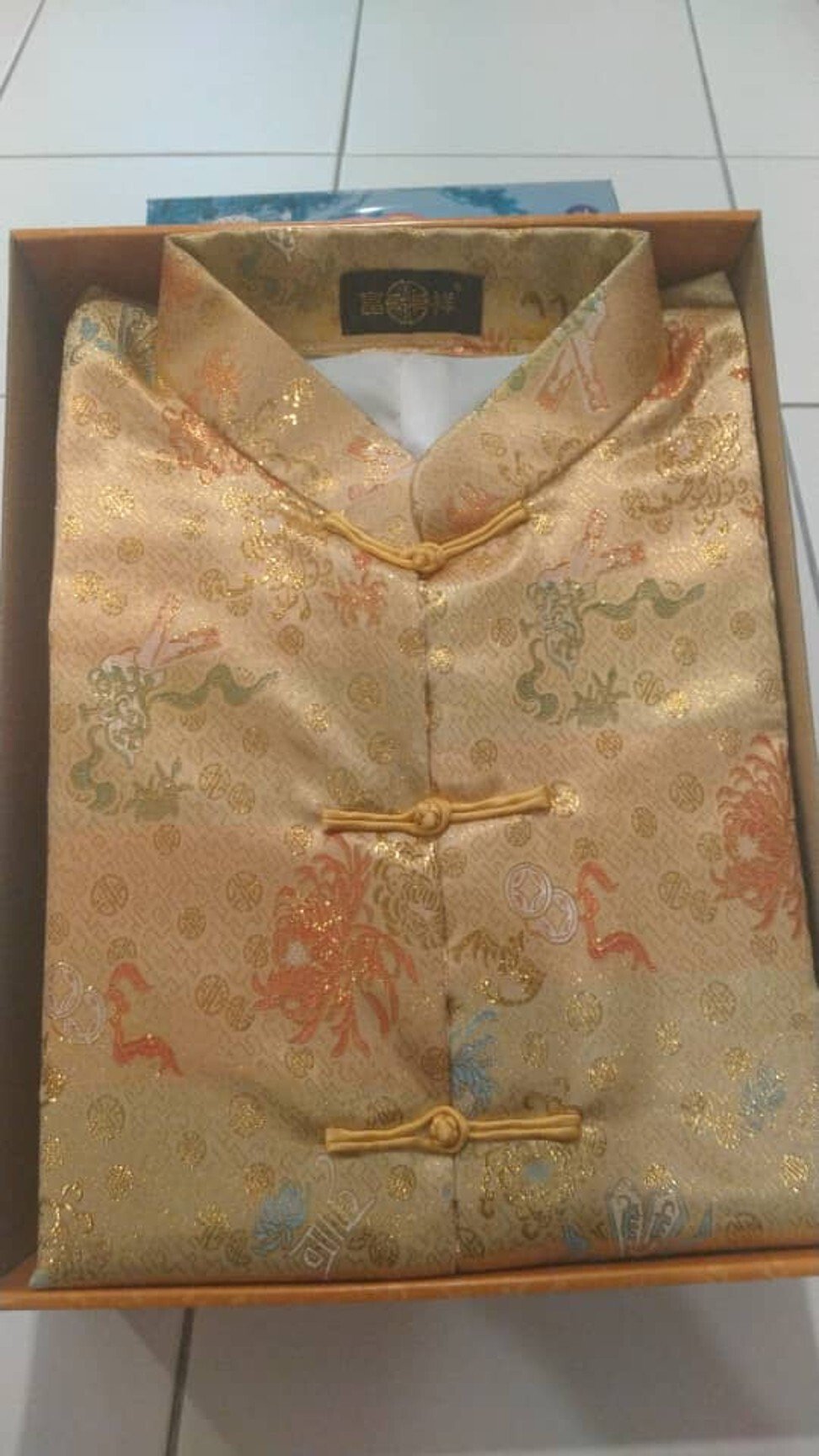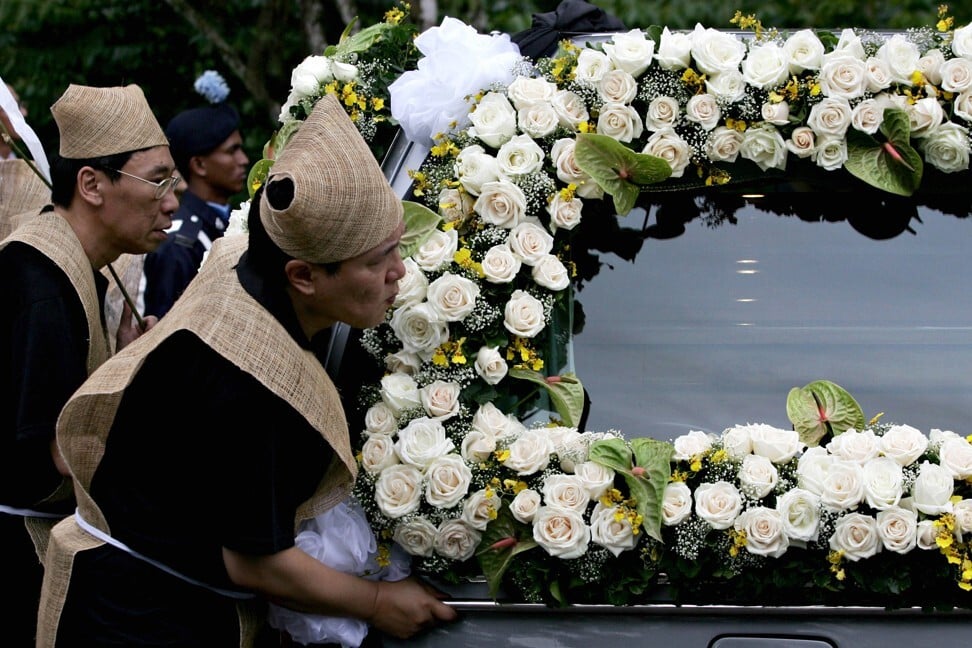
Raymond Lim Eng Sin, 39, puts on a black silk robe with ornate embroidery apparent on almost every surface. The sleeves are wide, like a kimono. A motif of a crane, a Chinese symbol for high nobility, takes up the top half of the back.
This isn’t a Shanghai Fashion Week runway showcasing a designer’s throwback pieces to sixth-century China. Lim isn’t an extra from a Cantonese period drama either. What he’s wearing is his uniform as a Taoist priest in contemporary Malaysia.
Where most cultural identifiers of the Chinese diaspora in Southeast Asia – the largest in the world – have all but vanished, there is one event where the traditional clothes of China have endured: death.
“I am the last in a long line of Taoist priests in my family – 17 generations in total. I am the fourth generation in Malaysia,” Lim says. He has no plans for his sons to succeed him.

The funerals of the overseas Chinese population in Malaysia and Singapore are known to be the most elaborate of all the races in these multi-ethnic Southeast Asian countries. And Lim works with the dialect group with the most pomp of them all: the Hokkiens, migrants from China’s Fujian province.
His clientele ranges from disfigured accident victims to billionaire Malaysian-Chinese casino tycoon Lim Goh Tong, the patriarch of one of Asia’s richest families who died in 2007.
Taoists believe in an endless cycle of life and death. For 49 days from their last breath, the dead embark on a treacherous journey through various realms of good and evil, encountering all the bad deeds in their life. Good deeds ease the process. Lim’s role is to guide the dead from postmortem limbo to a peaceful afterlife.
Families hold wakes where Lim chants and communicates with deities and the “primary lords of heaven” during his client’s netherworld quest, which hopefully results in a kind of heavenly paradise or a good rebirth. “Think of me as a lawyer pleading the deceased’s case with the gods,” he says.
Lim has worn the same style of robe throughout his decades-long career – the only difference that is 20 years ago he would have had to travel to China’s Chaozhou city to commission the US$720 pieces from seamstresses there, whereas today he can order more basic pieces from online marketplace Taobao. (Taobao is owned by Alibaba, which also owns the South China Morning Post.)

As for Lim’s clients, they are dressed in their finest. For women above 60 that means a gown like a qipao, or cheongsam; men wear a changshan, the male equivalent, consisting of a long robe and jacket with Mandarin buttons.
Those younger are dressed in black and white Western-style suits or one of their best outfits, each of which can cost anywhere from US$100 up to thousands of dollars, according to Emily Wong Bik Yen, who runs a business supplying funeral paraphernalia in Malaysia. “You’re meeting your maker. You have to wear your best,” she says.
A beautician for the dead, known as a “white lady”, will wash the body with flower-scented water before dressing it. An unclean body is said to invite punishment in the afterlife. Next, the white lady puts make-up on the corpse. Sometimes, when wakes last longer than five days – especially when the death occurs during the Lunar New Year, when funerals are forbidden to be held – they inject certain chemicals to keep the bodies looking more alive, Wong says.

Dr Hong Moi Hiong, an academic who studies the Cantonese community in Malaysia’s Sarawak state, says that the dead’s attire is also a status symbol.
“The deceased has become an ancestor, called ‘baigong’, as well as a ‘family god’. He or she is now able to protect the children and grandchildren or bring disaster to them,” she says.


The corpse is placed in an open coffin behind embellished altars standing at least two metres (six-and-a-half feet) high. As Lin leads the rites, mourning family members sit behind him. As Chinese culture openly prefers males to females, people are arranged from the eldest male son to the youngest female offspring. Their hands hold burning joss sticks. When Lin instructs, they kneel and bow to the gods.
What they wear symbolises their standing in the family. Those who carry the surname – sons, daughters and daughter-in-laws – are dressed in white T-shirts and black trousers. Paternal grandchildren wear dark blue versions of this attire; maternal grandchildren a brighter blue. Great-grandchildren wear light green. Anyone younger gets to wear red, to signify how lucky the deceased was to have lived through five generations.
A funeral procession for Lim Kim Hwa, widow of billionaire casino tycoon Lim Goh Tong:
Tradition may explain the endurance of these ancient rituals, but there’s a deeper, more emotional reason for these attires: filial piety.
“When mourners wear their robes, it is for them to remember their parents dressing them when they were young. The little cloth bracelet on their wrist? It’s to symbolise all the time their parents held their hand as children,” Lim explains.
Mourning pins, which also means “filial piety” in Chinese, are small pieces of coloured cloth pinned on shirt sleeves from the first day of the funeral, are worn for a period of either 49 or 100 days.
If this kind of traditional mourning clothing is abandoned and replaced with ‘disrespectful’ clothes, it will make people feel that the funeral has been desecrated, and at the same time they will feel deeply disgusted - Dr Hong Moi Hiong
Wearing bright colours, like yellow or red which signify happiness, is off-limits for mourning family members for up to three years. Such sartorial sacrifices reflect the typical Chinese value of reverence for their elders; they will put aside their appearance and personal comfort to show grief for the departed.
A bigger sacrifice can be seen from the bills these events command. Chinese funerals are exorbitant affairs. One with all the bells and whistles can cost US$36,000 or more – to compare, the average Malaysian annual household income is US$22,080. The poor are known to take bank loans to afford the steep price tags of funerals.
The reason? They believe in something akin to a karmic return on investment, Wong says. “The more you spend on the funeral, the more prosperity or good ‘feng shui’ the surviving family members will receive.”

Over the years, practicality has prompted shorter, even virtual funerals, where one need not even attend in person. Grieving families rarely wear full hemp vests and hats as in previous times. Where once they knelt throughout the priest’s chants, they now get to sit.
What will be the fate of traditional funeral attire?
Hong believes the younger generation should continue these traditions. “Funeral rituals not only comfort the souls of the bereaved, but also the mourners. If this kind of traditional mourning clothing is abandoned and replaced with ‘disrespectful’ clothes, it will make people feel that the funeral has been desecrated, and at the same time they will feel deeply disgusted.”
The clothes, she says, have “deep meaning, charm and are worth inheriting”.
From our archive







